
Lot 176

Helen Bradley M.B.E. (British 1900-1979) ◆§
Blackpool Sands with Punch and Judy Show
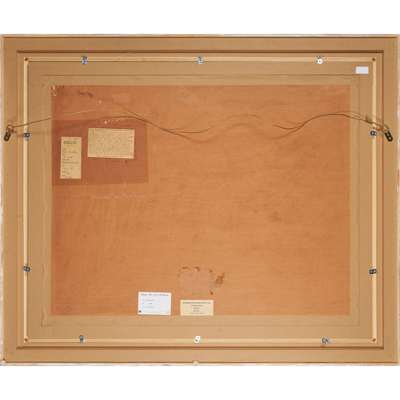
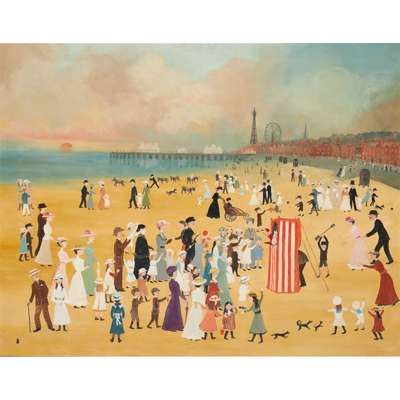
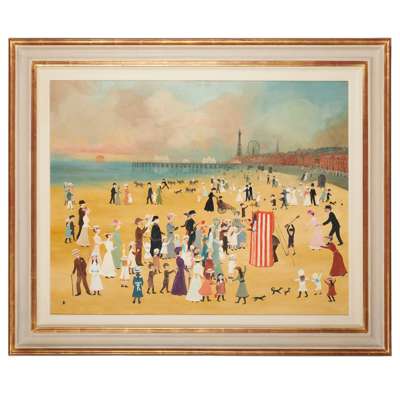



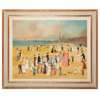
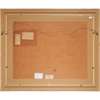
Auction: 29 October 2021 from 11:00 BST
Description
signed with fly insignia (lower left), oil on canvas on board
Dimensions
75cm x 94cm (29.5in x 37in)
Provenance
Exhibited:
Windsor & Eton Fine Arts Co. Ltd, 1974;
Bonhams, London, Modern British & Irish Art, 17 March 2010, Lot 13;
Haynes Fine Art, Broadway.
Footnote
'"Willie Murgatroyd", cried Miss Carter (who wore Pink) / "stop this minute" / George & I and the dogs Gyp & Barney, were at the back watching the Punch & Judy man. Willie & Annie Murgatroyd were there also, when all at once he lifted his spade and was about to whack the poor man when Miss Carter saw him. His mother rushed forward also, so I thought I had better get George back to mother and father before there was any trouble. They had stood at the back of the crowd to let Cousin Edward & Cousin Marion see the Punch & Judy show. Father held them up in turn. Mother, Aunt Charlotte & Aunt Frances were chatting when Aunt Frances noticed Bertie and Nellie Hope-Ainsworth standing near. "Look who's near you Jane", she said "Be careful what you say", for Nellie Hope Ainsworth listened to everyone's conversation and then passed it on to her mother who was enjoying the show. She was wearing her Parma Violet outfit. And the year was 1907 and it was late September at Blackpool. Helen Layfield Bradley 1971' (to label to reverse).
When Helen Bradley’s grandchildren expressed curiosity about Edwardian-era life, she turned to her paintbrushes. Seeking to illustrate how much the world had changed, Bradley drew on her memories of her childhood in Oldham, painting scenes of townspeople going about their daily lives. Her grandchildren must have delighted at the unfamiliar Edwardian clothes, the stiff high-necked dresses, the suits and top hats. Yet Bradley’s paintings also touched on ideas that transcend the intervening decades: each is a celebration of family life and community, and is realised with a deep and earnest affection.
The familial origins of Bradley’s artwork scarcely presupposed the phenomenal following she would garner in little more than five years. By the early 1970s, Bradley was an artist with an international reputation. Viewers delighted at the distinctive cast of characters that recur across her oeuvre, from the suited bank manager Mr. Taylor, to the now-famous Miss Carter, the family friend always clad in signature bubble-gum pink. The artist herself appears in many compositions as a child accompanied by her family and two pet dogs, Gyp and Barney. Bradley often drafted short narrative texts to accompany her paintings, further elucidating the memory she had felt compelled to paint.
From 1965 until her death in 1979, Bradley’s fame increased, earning the artist an MBE and generating BBC and NBC documentaries about her life, and a Northern Ballet adaptation of her work. Yet, Bradley had only resumed a regular painting practice in the early 1960s. Her artistic talent was evident from an early age: at thirteen, she was awarded a scholarship to attend Oldham Art School. Later, when living in London, Bradley recalled being particularly taken with exhibitions of early Chinese painting and displays of Persian miniatures at the British Museum, perhaps an early indication of her predilection for art with the capacity to transport the viewer to another world. Also familiar is the approach to figures largely in-profile and rendered in vivid colour, as well as the strong narrative function. Unfortunately, with the outbreak of war Bradley's plans to pursue the arts were cut short. In 1926, she married the artist and textile designer John Bradley, and would not consistently paint again until her mid-sixties.
It was a chance encounter with L.S. Lowry in the 1960s that encouraged Bradley to approach her painting as a personal document. Blackpool Sands with Punch and Judy Show likely dates to the early 1970s, and epitomises the artist’s ability to recall the past with playful tenderness, without succumbing to nostalgia. Bradley spent her childhood holidays in Blackpool where her grandparents lived, and they proved the most beloved and prolific of her childhood adventures. Brimming with the fun of the seaside - kite flying, donkey rides and Punch and Judy shows - Bradley’s works of Blackpool are perhaps her most iconic and charming works. They were generally painted on a larger scale than her other pictures, and this example is arguably one of the foremost examples of her Blackpool reminiscences. The composition evokes a leisurely family day at the beach punctuated by small moments of chaos: to the alarm of three onlooking children, a small boy brandishes a spade behind the Punch & Judy puppeteer, while Miss Carter rushes to intervene. Relishing in the poignancy of life’s quiet, incidental moments is quintessential Bradley.








